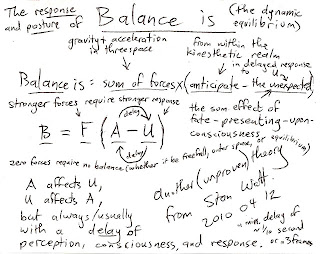Even more interesting is the entire process of taking into account what the character is aware of and already dealing with - the aniticipate - vis-a-vis what the character is not yet aware of and so is not yet balancing against - the unexpected. The delay from observation to reaction should be around 2 or 3 frames. Depending on the nature of the unexpected occurrence, this means that the character can deal with most situations but when change occurs very quickly (or is obscured from the character's perception for some reason or another) the character will not be able to comfortably deal with that. Well, then you have loss of balance and a fall / trip / plunge / what have you. But even then the character responds as best it can to catch itself and rebalance.
Stronger forces call for stronger counter-anticipation and motions. Smaller forces (that is, in play upon the character), oddly enough, leave a character more vulnerable to the unexpected. A character that is already in motion is in a safer situation with regards to the unexpected than a character that is at rest. The force at play can be converted to many actions, so this conversion potential makes any sort of motion useful even before a clear intent has yet been arrived upon. So jumping in response to danger, for example, will occur reflexively; then by the time the body has begun to return downwards, the mind will have been able to choose a course of action and can then apply that downwards force into a more powerful escape or action that it will now have arrived upon. It is interesting how the unexpected is factored into the motion and posturing. It is a sort of knowing of the potential nature of the unknown.
This makes sense when considering the animal world, where the natural response to perceived threat is escape; fright and flight. Any reaction is usually better than no reaction, potential embarrassment is better than potential injury, and this is built into the system. Even in a static posture, dynamic equilibrium can be at play in terms of potential motion resulting from the pose. So, a fighter's stance will have legs set apart and knees slightly bent. Although this pose is static, it anticipates motion, permitting potential motion in any direction at a moment's notice. As opposed to a vertical stance, which requires a side-step before directional motion is possible, a split-second delay that could be deadly in a battle situation. A small creature will hunch down for safety. Aside from benefits of concealment, this also accomplishes a similar wide-base stance that enables escape motion in any direction from that starting point. The A-frame stance simply needs one leg to be lifted for motion to initiate in that direction. The imbalance enables the creature to have greater equilibrium of security.
Yet in a fully benign context of walking, the A-frame stance is just as fundamental for the motion, and is reiterated in roughly the same manner whatever the current intentionality of motion is: beginning, continuing / perpetuating, ending, or reversing.
All of these processes are descriptions of dynamic equilibrium within an intelligent or thinking system.
I know that in the robotic sciences there are all sorts of formulas and feedback loops that are now fairly well established in proceduralizing these sorts of things. What I'm exploring here would be a layman's approximation of such things. But a simple device or mnemonic could be of some use. I wonder how similar or different this one is from what else is out there? Furthermore, with animation you are going to be layering personality and character into the whole process; and top all of that off with interesting timing and motion. If the character is balanced, the sense of balance will show itself in the motion as well, in terms of a sort of confidence about the situation. If the character is unbalanced, the motion will again be different to also reflect the character's emotion: nervous, unnerved, or perhaps sufficiently optimistic to still maintain confidence, as with an idiot savant, drunken walk, or goof-hero personality. But it is interesting that a thinking system is both inherently unbalanced and designed to operate through ongoing processes of imbalance. So a lot of motion is well within the familiar realm of human motion, and the body goes about accomplishing most of it with little need for attention from higher-level conscious thought.
I really look forward to exploring these sorts of things in greater depth through the art of animation. In terms of course content, it's still a bit farther down the road. But there are already places here and there in the assignments where it is possible to start taking these things into consideration.
I also really look forward to applying, overtop of the physics, the dream-realms, once a situation bears the freedom to explore that way as well. That is a whole other matter, yet for it to work well it is bound to call for very similar considerations all the same.
As with many artistic tasks, the trick is making conscious use of subconscious routines and, to some extent, gaining control over the subconscious.

No comments:
Post a Comment